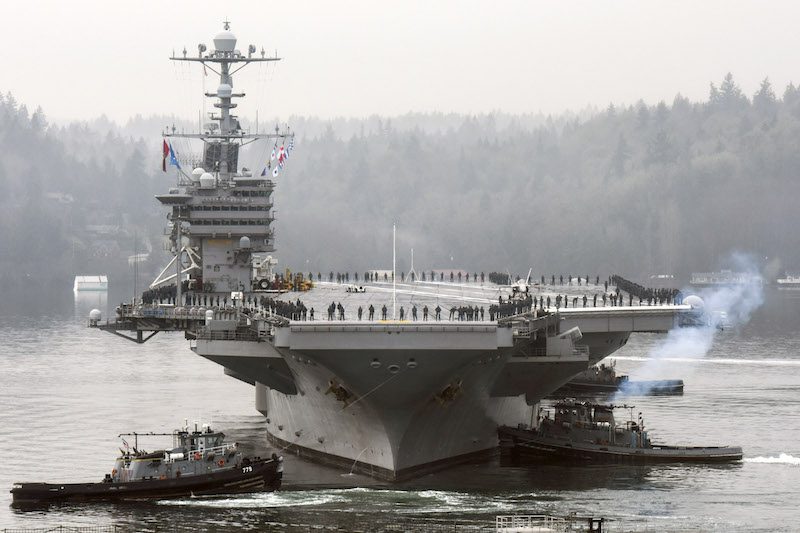USS John C. Stennis (CVN 74) gets underway for a western Pacific deployment from Naval Base Kitsap-Bremerton, Washington, January 15, 2016, after having gone through a recent dry dock period at the Puget Sound Naval Shipyard. U.S. Navy Photo
 By David Alexander
By David Alexander
WASHINGTON, Jan 16 (Reuters) – The U.S. Navy will formally deploy its so-called “Great Green Fleet” on Wednesday, sending warships to sea on biofuels even though oil prices have dropped 70 percent since congressional Republicans first criticized the high cost of alternative fuels.
Navy Secretary Ray Mabus told Reuters the deployment is the next step in a fleet-wide effort that has seen the Navy cut its oil consumption by 15 percent since he took charge in 2009 and the Marine Corps curb its use by 60 percent.
A focus on energy and energy-saving technology gives the U.S. Navy a military advantage, Mabus said. An amphibious assault ship like the USS Makin Island, which uses a dual electric-diesel propulsion system, can stay on station three times longer than a conventionally powered vessel, he said.
“It gives us an edge tactically, it gives us an edge strategically,” Mabus said. “It keeps fuel from being used as a weapon against us.”
Mabus and U.S. Agriculture Secretary Tom Vilsack will be on hand in San Diego on Wednesday for the formal deployment of the Great Green Fleet, when diesel ships in a carrier strike group led by the nuclear-powered USS John C Stennis refuel with a diesel-biofuel blend.
Mark Cancian, an analyst at the Center for Strategic and International Studies and former White House budget official, said the initiative is as much about environmental symbolism as cost savings or tactical advantage.
Many congressional Republicans objected three years ago when the Navy sought and won support for defense subsidies to help three private firms build biofuel refineries. With oil now selling around $30 a barrel, that skepticism remains.
“They have not changed their position, which is that these are too expensive and not needed,” Cancian said.
FUEL FROM WASTE
The Defense Department uses about 14 million gallons of fuel a day, with the Navy responsible for about a quarter of that, according to figures from the Defense Logistics Agency.
When the Navy first tested biofuel versions of marine diesel and jet fuel in 2012, it spent eye-popping sums for small amounts.
In one case it paid $424 a gallon for 20,055 gallons of biofuel based on algae oil. In another it spent nearly $27 per gallon for 450,000 gallons of biofuel, later mixed into a 50-50 blend. The $15-per gallon-cost was four times the price of conventional fuel at the time.
The fuel being used for the Great Green Fleet deployment is a competitively priced blend of 90 percent diesel and 10 percent biofuel based on a beef tallow feedstock, Navy officials said.
A California firm, AltAir Fuels, is contracted to supply 77 million gallons of the fuel between Oct. 1, 2015, and Sept. 30, 2016.
The Navy pays $2.05 per gallon, thanks in part to a subsidy of 15 cents per gallon from the Commodity Credit Corp., a government-owned enterprise that supports farm products.
To boost production of alternative fuels, the Navy has awarded $210 million to help three firms build refineries to make biofuels using woody biomass, municipal waste and used cooking grease and oil. The U.S. Department of Agriculture is providing an additional $161 million in crop supports.
The refineries are expected to begin operations this year, with full production not likely until 2017. To further encourage biofuel production for the Navy, Mabus said he has signed deals to buy from Italy and Chile once firms there begin producing.
The Navy has yet to contract with a company to produce alternative jet fuel, in part because of the growing commercial aviation market.
Agriculture Secretary Tom Vilsack said developing biofuel refineries for aviation fuel offered great potential for creating jobs in the U.S. rural economy.
“There is a huge market opportunity here if we can get the technology right,” Vilsack told Reuters. (Reporting by David Alexander; Editing by SImon Cameron-Moore)
(c) Copyright Thomson Reuters 2016.

 Join The Club
Join The Club











